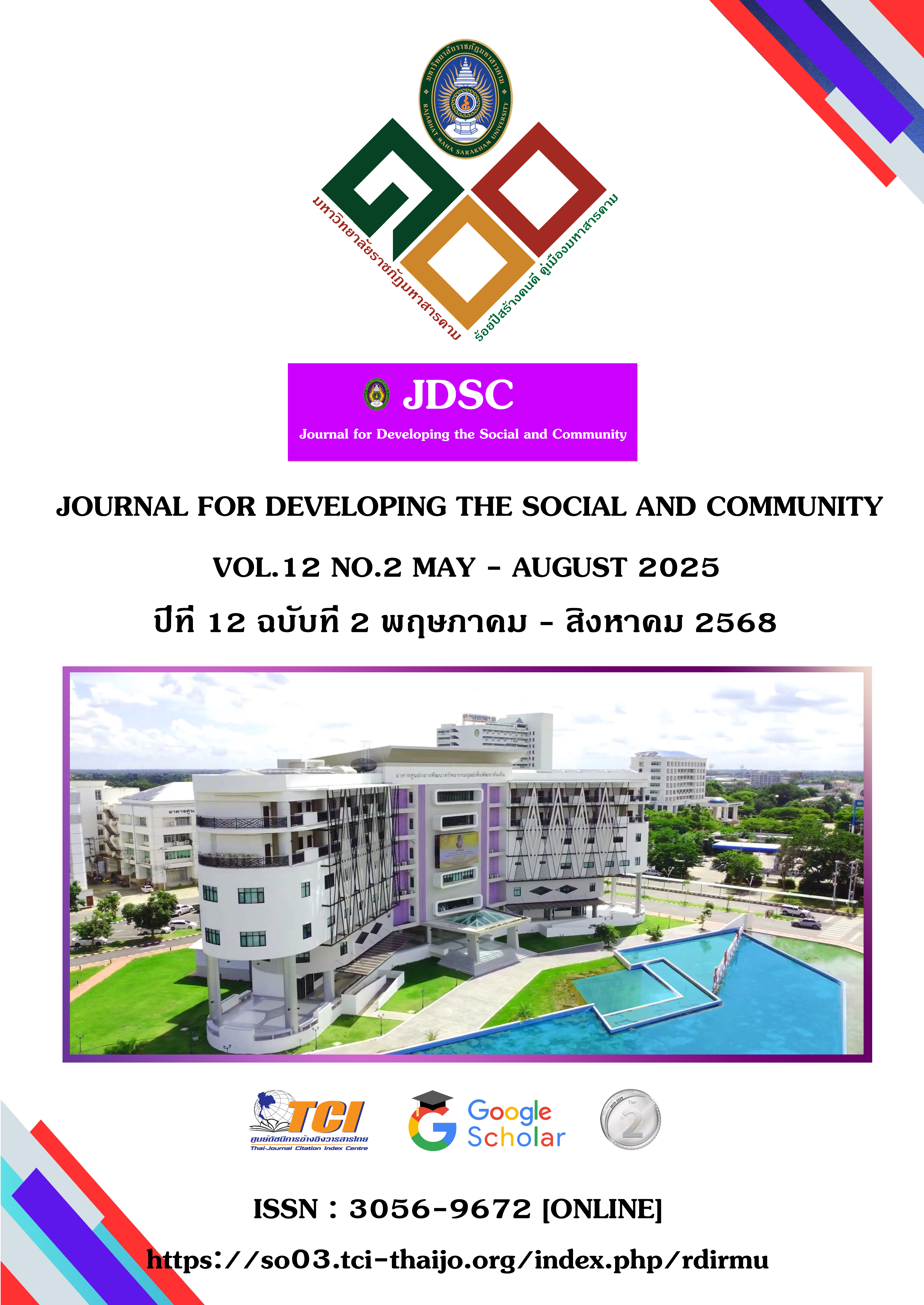Causal Factors Affecting the Financial Adequacy of Employed Person in Pre-Retirement Age in the Northeast
Keywords:
Financial adequacy, Financial behavior, Psychological factors, Economic factorsAbstract
Background and Aims: The financial adequacy of pre-retirement working individuals is influenced by several key factors, including income, consistent saving patterns, and financial behaviors that affect spending and investment decisions. Additionally, labor market stability, government welfare, and debt obligations are significant variables that determine an individual's ability to prepare financially for retirement. Without proper financial planning, there is a risk of facing financial insufficiency in the future. This study aims to: (1) develop a causal model of factors affecting financial adequacy among pre-retirement working individuals; (2) analyze the direct influence of causal factors on financial behavior; and (3) examine the indirect influence of causal factors on financial adequacy through financial behavior as a mediating variable.
Methodology: This research is a quantitative study. The sample group consisted of 456 employed individuals who are insured under Article 33 (compulsory section) of the Social Security System in the Northeastern region of Thailand. A two-stage sampling method was used, which included purposive non-probability sampling followed by stratified probability sampling. The research instrument was a questionnaire. The statistical methods used included descriptive statistics and inferential statistics for developing a structural equation model and conducting confirmatory factor analysis. The study also involved model analysis and an assessment of model fit.
Results: 1) The developed model demonstrated a good fit with the empirical data, indicating that the causal model of factors influencing financial adequacy appropriately explains the relationships among the relevant variables. 2) Financial literacy has a significant direct influence on financial behavior. Financial attitude also shows a significant direct influence on financial behavior. Additionally, motivation for financial planning toward retirement has a direct effect as well. And 3) Financial literacy indirectly influences financial adequacy through financial behavior. Likewise, financial attitude has an indirect influence, and motivation for planning also indirectly affects financial adequacy. Meanwhile, financial behavior itself has a significant direct influence on financial adequacy.
Conclusion: Good financial behavior leads to financial adequacy. Such behavior is influenced by psychological factors, economic conditions, and socialization factors. Therefore, the government should place importance on promoting adequate income levels for working individuals, including setting appropriate minimum wages that are sufficient to meet daily living expenses. Moreover, it is essential to enhance access to diverse financial resources in ways that do not create excessive debt burdens. Additionally, efforts should be made to encourage pre-retirement workers to develop self-awareness regarding their financial capabilities, foster satisfaction with saving, and build confidence in their financial decisions. These actions will contribute to better financial behavior and ultimately lead to appropriate levels of financial adequacy.
References
กรมกิจการผู้สูงอายุ. (ไม่ทราบปีที่พิมพ์). ข้อมูลความรู้เกี่ยวกับผู้สูงอายุ. สืบค้นเมื่อ 11 พฤศจิกายน 2564, จาก https://www.dop.go.th/th/know/1/926
สถาบันบัณฑิตพัฒนบริหารศาสตร์. (2566). ผลสำรวจของนิด้าโพล พ.ศ. 2566. สืบค้นเมื่อ 14 กันยายน 2566, จาก https://nidapoll.nida.ac.th/survey_detail?survey_id=625
สำนักงานประกันสังคม. (2564). ข้อมูลจำนวนผู้ประกันตน มาตรา 33. สืบค้นเมื่อ 14 กันยายน 2566, จาก https://catalog.sso.go.th/group/33
สำนักงานสถิติแห่งชาติ. (2565). รายงานสถานการณ์ผู้สูงอายุไทย พ.ศ. 2565. สืบค้นเมื่อ 14 กันยายน 2566, จาก https://thaitgri.org/?p=40208
อธิต ทิวะศะศิธร์, และคณะ. (2563). ปัจจัยเชิงสาเหตุที่ส่งผลต่อพฤติกรรมทางการเงินของผู้มีงานทำใน ภาคตะวันออกเฉียงเหนือของไทย. วารสารวิชาการเซาธ์อีสท์บางกอก (สาขามนุษยศาสตร์และสังคมศาสตร์), 6(1), 62–72.
Bandura, A. (2006). Guide for constructing self-efficacy scales. In F. Pajares & T. Urdan (Eds.), Self-efficacy beliefs of adolescents (pp. 307–337). Information Age Publishing.
Brounen, D., Koedijk, E. K., & Pownall, R. (2016). Household financial planning and savings behavior. Journal of International Money and Finance, 69, 95–107.
Dew, J., & Xiao, J. J. (2011). The Financial Management Behavior Scale: Development and validation. Journal of Financial Counseling and Planning, 22(1), 43–59.
Gao, W., Li, X., & Zhu, Y. (2014). Qian xi wo guo fei zheng gui jin rong ji gou de fa zhan [The growth of informal financial institutions in China]. Shangye Jingji, 2014(2), 116–118. http://www.cqvip.com/read/read.aspx?id=48964238#
Hair, J. F., Black, W. C., Babin, B. J., & Anderson, R. E. (2014). Multivariate data analysis (7th ed.). Pearson Education.
Huston, S. J. (2010). Measuring financial literacy. The Journal of Consumer Affairs, 44(1), 296–316.
Marzieh Kalantarie Taft, M., Hoseini, S. M., & Zarei, F. (2013). The relation between financial literacy, financial wellbeing and financial concerns. International Journal of Business and Management, 8(11), 63–75.
Lown, J. M. (2011). Development and validation of a financial self-efficacy scale. Journal of Financial Counseling and Planning, 22(2), 54–63.
Mary, M. B. (2013). The financial behaviors of soldiers before and after deployment (Doctoral dissertation). Kansas State University.
Munt, I. M. (2016). A quantitative comparison of financial wellness between boomerang and non-boomerang children ages 18–35 (Doctoral dissertation). Capella University.
Schumacker, R. E., & Lomax, R. G. (2010). A beginner’s guide to structural equation modeling (3rd ed.). Lawrence Erlbaum Associates.
Spann, M. S. (2014). Financial wellness in the workplace (Doctoral dissertation). Kansas State University.
Strömbäck, C., Lind, T., Skagerlund, K., Västfjäll, D., & Tinghög, G. (2017). Does self-control predict financial behavior and financial well-being? Journal of Behavioral and Experimental Finance, 14(C), 30–38.
Van Rooij, M., Lusardi, A., & Alessie, R. (2011). Financial literacy, retirement planning and household wealth. NBER Working Paper No. 17339. https://www.nber.org/papers/w17339
Xiao, J. J., Chen, C., & Chen, F. (2014). Consumer financial capability and financial satisfaction. Social Indicators Research, 118(1), 415–432.
Xiao, J. J., & Porto, N. (2017). Financial education and financial satisfaction: Financial literacy, behavior and capability as mediators. International Journal of Bank Marketing, 35(5), 805–817.
Xu, Y., Beller, A. H., Roberts, B. W., & Brown, J. R. (2015). Personality and young adult financial distress. Journal of Economic Psychology, 51, 90–100.
Yilan Xu , Andrea H. Beller, Brent W. Roberts, Jeffrey R. Brown (2015). Personality and young adult financial distress
Downloads
Published
How to Cite
Issue
Section
License
Copyright (c) 2025 Journal for Developing the Social and Community

This work is licensed under a Creative Commons Attribution-NonCommercial-NoDerivatives 4.0 International License.
Articles that are published are copyrighted by the authors of the articles







